SAPPORO ART EXIHITION AQUA LINE
HAPPENINGText: Ayumi Yakura
There are many art exhibitions in the world with the theme of water. However, Sapporo Art Museum in Sapporo Art Park is currently showing the Aqua Line: Art Along the Shore exhibition, which draws attention to the lines created by water. The exhibition accumulates works by 14 artists from different disciplines such as Japanese painting, oil painting, photography, three-dimensional works, calligraphy, and installation.
The subtitle, “Art Along the Shore” shows how the works in the exhibition do not simply express water in direct ways. There are works that have water as a source for ideas, or works that gather imagination around water. The exhibition space is freshly filled with carefully selected current artists from Hokkaido.
Visitors can devote themselves to the familiar theme of water, flowing through the lines of water in 14 different ways. The visitors can relax and enjoy contemporary art, which does not have rules for appreciating the works. The visitors will be able to feel pure aesthetics from the exhibition that guides the visitor in casually controlled ways, and with text on the panels accompanying the works.
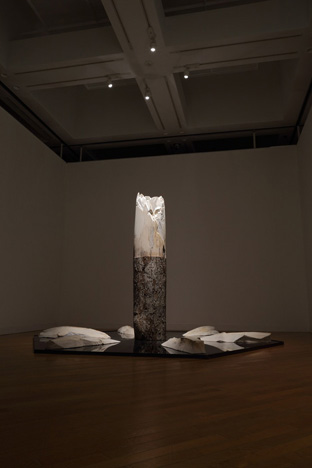
“SNOWFLAKE” Kineta Kunimatsu, 2013, Photo: © Seiji Yamagishi
As you walk in, you will see the work “SNOWFLAKE” by Kineta Kunimatsu standing solemnly. At the center of an acrylic plate, a tree trunk of a height of 2.55m stands, lights from the ceiling drop shadows and lights on the bark like water drops. The top half of the trunk is stripped and white parts inside are visible. Tips that are carved like ice pillars, and you will see the irregular reflections of Swarovski.
Wooden sculptures that surround the trunk are like icebergs. You will feel conditioned sensitivities from the work and as you walk around and observe the ridgelines of the sculptures. It seems as if the artist has curved the materials by having conversations with them and taking in the way the materials exit.
When the work is observed from the above, they are positioned like examined with a microscope. When observed from the sides, it is like seeing icebergs in the ocean. It is a piece that can make you imagine yourself in the bird-eye view, whilst standing at a border of real image and fantasy.
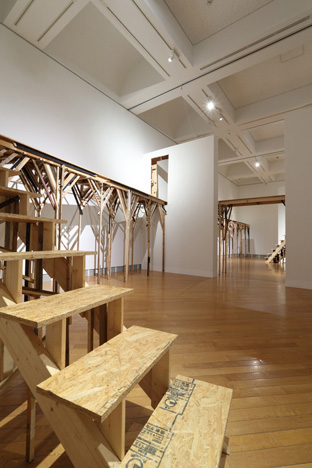
“Zero Meters Above Sea Level / Ishikari Low Area” Ryo Yamada, 2013 Photo: © Seiji Yamagishi
Ryo Yamada’s “Zero Meters Above Sea Level / Ishikari Low Area” is a pier with a height of 2 meters and a length of 24.58 meters. You will hear the threatening creak of stairs made out of slim scrap woods as you walk up. Some people will feel weak at the knees from the height since the width of the passage is only 60cm. You will feel scared as if walking on a tightrope because there is no handrail or a wall to lean on.
Four hundred thousand to one million years ago the sea level was up to about 2 meters above the current ground level. By walking the height with unstable condition, the work recalls the sea level that is now absent. People build bridges because there is something they want to connect. If you choose to not walk up the stairs, you can look upwards and imagine yourself staring at the surface of the ocean from 2 meters below the sea level.
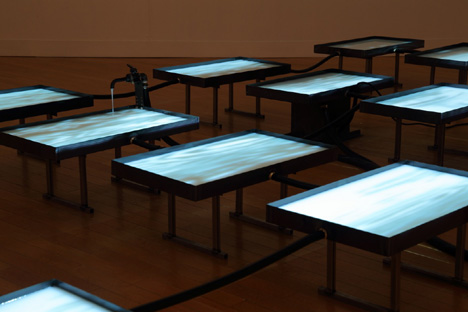
“Acknowledgement of Water. My Entertainment for Water” Satoshi Hata, 2013 Photo: © Seiji Yamagishi
Next in the exhibition, you will encounter a work called “Acknowledgement of Water. My Entertainment for Water” by Satoshi Hata. He is recognized as a regional director for Sapporo International Art Festival 2014. His works will strike the viewers with pure enjoyment when the viewers stop reading too much into the meaning of the works.
The work has an overall structure with an impression of seeing the future from the past. There are 16 simple metal boxes lined up in a dark room. From the taps, unclear water flows and fills the boxes, drawing curved lines, and circulating. On the surface of the water, projection of various images of water and an assortment of sounds appears and disappears in a 4 minutes and 40 seconds cycle.
The idea of the work comes from a theory of a hypothetical level that “water has memory.” If water has memory, we can pour our appreciation and respect to the surface of water using multiple methods of expression, and circulate good memories to the water that is the source of all creation. Sincerity and respect towards water seems too pure and defenseless, however, that is the strength of expression in art.
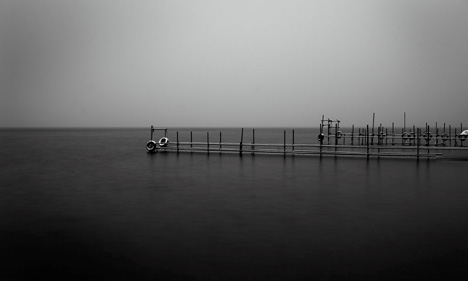
“20100214192908titose” Yoshiaki Maezawa, 2010 © Yoshiaki Maezawa
3 out of 14 exhibitors are photographers. 3 styles of works are exhibited by 3 photographers shooting sceneries of Hokkaido related to water in 3 different concepts.
In Yoshiaki Maezawa’s works, images of sights of water in Hokkaido are stored in a black box and emerge as if it is emitting lights. As you look closely, you will see some colours in some photographs that are monochromatic.
In a photograph that records Hokkaido in 2009 from the sky, Toyohira River in a misty city is captured. The viewer will recognize a line of the river that is less likely to be noticed from the earth. The viewer will feel calm from the fact that the beautiful river still exists in the city. In a photograph that shoots the surface of a lake in a forest in Chitose City, the perfectly clear air of Hokkaido, that can not be recognized with naked eyes, is documented as if it is reflecting lights to the sky.
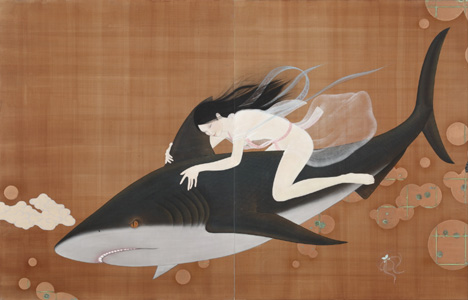
“Escualo” Amanatsu Aono, 2010 Photo: © Seiji Yamagishi
Amanatsu Aono is the only Japanese-style painter in the exhibition. What is interesting about her works is how she follows techniques from ancient Japan, yet ideas occur to her from music performed with percussion instruments from South America.
“Batucada” is a work that rearranged Daiitokumyouou from esoteric Buddhism into a female character. The viewer will receive an impression of being free and uncontrolled although it is a god, from an appearance of the character riding on a water buffalo with three faces, six arms and six legs. “Escualo” with a female figure dressed in thin robe and controlling a shark creates a high-minded, yet fragile atmosphere. The new work “Gansouzu“ has a wide screen and shows a seashore with white wave lines making large whirls, a beautiful mermaid with blushed cheeks and lips, seems to be thinking about someone.
All 3 works are structured in stylish ways by arranging traditional patterns into modern forms such as the wavy lines and the checkered patterns.
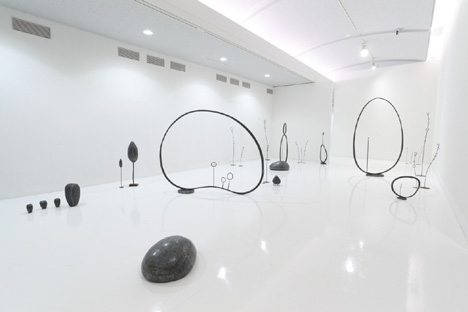
“Shizukana Soyosoyo” Shoko Yoshinari, 2013 Photo: © Seiji Yamagishi
Shoko Yoshinari from Horokanai City is currently 26 years old and the youngest among the 14 artists. This exhibition could be said to be exhibition with a wide age range since Hokumei Nakano, a calligrapher, is 90 years old and the oldest among the artists.
“Shizukana Soyosoyo” shows the exhibiting space itself as a work of art by placing metal art works in various sizes like plants growing in a forest.
The viewer will receive an impression of metals bended in circular forms as cute; however, each piece seems to be independent. The pieces are quiet yet create a soft atmosphere that invites the viewers. The artwork has a relaxed playfulness that is casual and pleasant. The work possesses creativity that formulates scenery in the space with each structure that is still thin and simple.
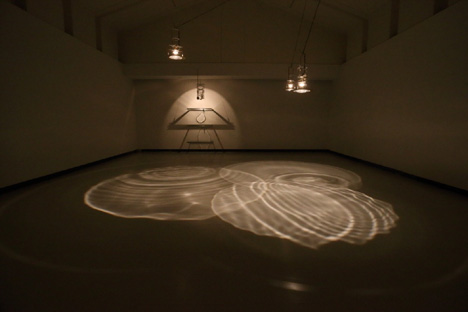
“Shizuku wo Kiku” Hideaki Sasaki, 2010-2013 Photo: © Seiji Yamagishi
In the Second Venue entrance, inside a black curtain is a space for “Shizuku wo Kiku” by Hideaki Sasaki. With only the weak sounds of water drops emerging from the silence, water drops fall to a pool of water in a glass plate and move the water. A lamp lights the pool of water, and large rings of light projected on a floor shake. The viewer can feel the depth of water on a flat surface of the floor as the devise is far from the floor the outline of lights are fainted and the rings overlap as the puddles expand. The visitors can walk in the layers of lights gently shaking.
At the wall inside, there is an artwork that has three pieces of glass plates piled on top of each other. From a device, a drop of water drops and accumulates at the top plate. Then it will flow down to the next plate and drop into a water surface expanded with surface tension. Shadow reflected on a wall moves like a living creature.
I was not sure how long it had been since I started to stare at the space. It is an artwork that changes its states along with passage of time. It is recommended to experience the artwork in the beginning to purify the five senses for aesthetic experiences or experience the piece after enjoying diverse works by 13 artists and end the aesthetic experience by being surrounded by gentle lights of water.
Sapporo Art Exhibition has a long history that before moving to Sapporo Art Park in 2008 to start exhibiting every year with their original themes, they were using Sapporo Citizen’s Gallery as the venue.
The venue has features that are widely known such as “Sapporo Sculpture Garden”(closed in winter period) that allow people to enjoy sculptures in a nature. However, we should also keep our eyes on a characteristic of the venue that will not only exhibit artists highly recognized outside of Hokkaido and Japan but also constantly exhibit, using their planning abilities, artists from Hokkaido and new cultures that they discover through their own values.
Sapporo Art Exhibition will be a site for International Art Festival 2014 and could expect the site to be a place for people from various genres to meet. There is a bright view that people who gather in Sapporo Art Park to feel a touch through art and what they develop there to extend outwards.
Sapporo Art Exihition Aqua Line Art along the shore
Date: November 30th, 2013 – February 16th, 2014
Closed on Mondays (If national holiday, closed on the coming Tuesday), New Years eve and New Years (December 29th – January 3rd)
Opening hours: 09:45 – 17:00 (Entrance until 16:30)
Exhibiting Artists: Amanatsu Aono, Kineta Kunimatsu, Hideaki Sasaki, Tsuyuguchi Keiji, Shin Tokumaru, Hokumei Nakano, Satoshi Hata, Aki Maekawa, Yoshiaki Maezawa, Yoshiki Miyakawa, Yasuji Yagi, Kiyomi Yamada, Ryo Yamada, Shoko Yoshinari
https://sapporo-art-museum.jp
Text: Ayumi Yakura
Translation: Meiko Maruyama





